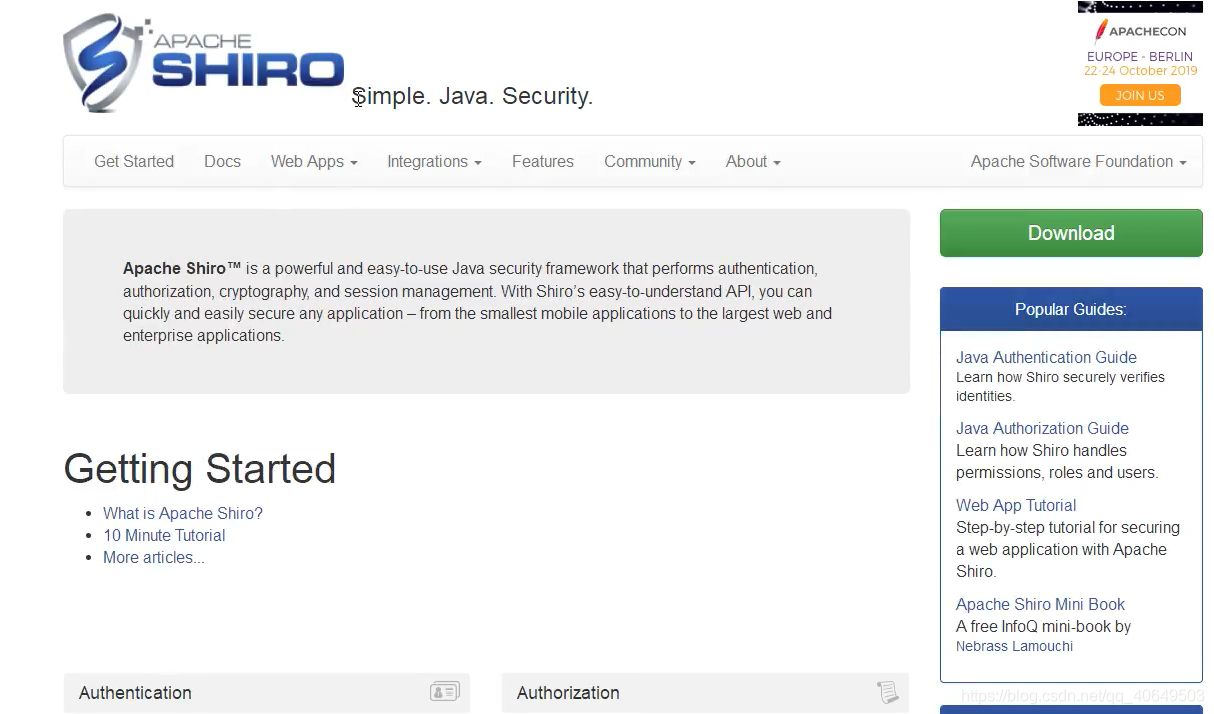跟着狂神学Shiro
Shiro
什么是Shiro?
●Apache Shiro是一个Java 的安全(权限)框架。
●Shiro可以非常容易的开发出足够好的应用,其不仅可以用在JavaSE环境,也可以用在JavaEE环境。
●Shiro可以完成,认证,授权,加密,会话管理,Web集成,缓存等.
●下载地址: http://shiro.apache.org/

有哪些功能

●Authentication: 身份认证、登录,验证用户是不是拥有相应的身份;
●Authorization:授权,即权限验证,验证某个已认证的用户是否拥有某个权限,即判断用户能否进行什么操作,如:验证某个用户是否拥有某个角色,或者细粒度的验证某个用户对某个资源是否具有某个权限!
●Session Manager: 会话管理,即用户登录后就是第-次会话,在没有退出之前,它的所有信息都在会话中;会话可以是普通的JavaSE环境,也可以是Web环境;
●Cryptography: 加密,保护数据的安全性,如密码加密存储到数据库中,而不是明文存储;
●Web Support: Web支持,可以非常容易的集成到Web环境;
●Caching: 缓存,比如用户登录后,其用户信息,拥有的角色、权限不必每次去查,这样可以提高效率
●Concurrency: Shiro支持多线程应用的并发验证,即,如在-个线程中开启另-一个线程,能把权限自动的传
播过去
●Testing:提供测试支持;
●RunAs:允许一个用户假装为另-一个用户(如果他们允许)的身份进行访问;
●Remember Me:记住我,这个是非常常见的功能,即一-次登录后, 下次再来的话不用登录了
Shiro架构(外部)
从外部来看Shiro,即从应用程序角度来观察如何使用shiro完成工作:

●subject: 应用代码直接交互的对象是Subject, 也就是说Shiro的对外API核心就是Subject, Subject代表了当前的用户,这个用户不-定是一个具体的人,与当前应用交互的任何东西都是Subject,如网络爬虫,机器人等,与Subject的所有交互都会委托给SecurityManager; Subject其实是一一个门面, SecurityManageer 才是
实际的执行者
●SecurityManager: 安全管理器,即所有与安全有关的操作都会与SercurityManager交互, 并且它管理着所有的Subject,可以看出它是Shiro的核心,它负责与Shiro的其他组件进行交互,它相当于SpringMVC的DispatcherServlet的角色
●Realm: Shiro从Realm获取安全数据 (如用户,角色,权限),就是说SecurityManager要验证用户身份,那么它需要从Realm获取相应的用户进行比较,来确定用户的身份是否合法;也需要从Realm得到用户相应的角色、权限,进行验证用户的操作是否能够进行,可以把Realm看DataSource;
Shiro架构(内部)

●Subject: 任何可以与应用交互的用户;
●Security Manager:相当于SpringMVC中的DispatcherSerlet; 是Shiro的心脏, 所有具体的交互都通过Security Manager进行控制,它管理者所有的Subject, 且负责进行认证,授权,会话,及缓存的管理。
●Authenticator:负责Subject认证, 是-一个扩展点,可以自定义实现;可以使用认证策略(Authentication Strategy),即什么情况下算用户认证通过了;
●Authorizer:授权器,即访问控制器,用来决定主体是否有权限进行相应的操作;即控制着用户能访问应用中
的那些功能;
●Realm: 可以有-一个或者多个的realm, 可以认为是安全实体数据源,即用于获取安全实体的,可以用JDBC实现,也可以是内存实现等等,由用户提供;所以- -般在应用中都需要实现自己的realm
●SessionManager:管理Session生 命周期的组件,而Shiro并不仅仅可以用在Web环境,也可以用在普通的JavaSE环境中
●CacheManager: 缓存控制器,来管理如用户,角色,权限等缓存的;因为这些数据基本上很少改变,放到缓存中后可以提高访问的性能;
●Cryptography:密码模块,Shiro 提高了一些常见的加密组件用于密码加密, 解密等
Shiro快速开始
准备工作
-
创建一个普通maven项目
springboot-08-shiro,然后删除src目录,这样的话就可以在这个项目里新建很多model. -
在
springboot-08-shiro里新建modelhello_shiro -
找到文件

在pom.xml中复制
<dependencies>
<dependency>
<groupId>org.apache.shiro</groupId>
<artifactId>shiro-core</artifactId>
</dependency>
<!-- configure logging -->
<dependency>
<groupId>org.slf4j</groupId>
<artifactId>jcl-over-slf4j</artifactId>
<scope>runtime</scope>
</dependency>
<dependency>
<groupId>org.slf4j</groupId>
<artifactId>slf4j-log4j12</artifactId>
<scope>runtime</scope>
</dependency>
<dependency>
<groupId>log4j</groupId>
<artifactId>log4j</artifactId>
<scope>runtime</scope>
</dependency>
</dependencies>
更改细节
<dependencies>
<dependency>
<groupId>org.apache.shiro</groupId>
<artifactId>shiro-core</artifactId>
<version>1.4.1</version>
</dependency>
<!-- configure logging -->
<dependency>
<groupId>org.slf4j</groupId>
<artifactId>jcl-over-slf4j</artifactId>
<version>1.7.21</version>
<scope>runtime</scope>
</dependency>
<dependency>
<groupId>org.slf4j</groupId>
<artifactId>slf4j-log4j12</artifactId>
<version>1.7.21</version>
<scope>runtime</scope>
</dependency>
<dependency>
<groupId>log4j</groupId>
<artifactId>log4j</artifactId>
<version>1.2.17</version>
<scope>runtime</scope>
</dependency>
</dependencies>
复制
log4j.properties
log4j.rootLogger=INFO, stdout
log4j.appender.stdout=org.apache.log4j.ConsoleAppender
log4j.appender.stdout.layout=org.apache.log4j.PatternLayout
log4j.appender.stdout.layout.ConversionPattern=%d %p [%c] - %m %n
# General Apache libraries
log4j.logger.org.apache=WARN
# Spring
log4j.logger.org.springframework=WARN
# Default Shiro logging
log4j.logger.org.apache.shiro=INFO
# Disable verbose logging
log4j.logger.org.apache.shiro.util.ThreadContext=WARN
log4j.logger.org.apache.shiro.cache.ehcache.EhCache=WARN
shiro.ini
[users]
# user 'root' with password 'secret' and the 'admin' role
root = secret, admin
# user 'guest' with the password 'guest' and the 'guest' role
guest = guest, guest
# user 'presidentskroob' with password '12345' ("That's the same combination on
# my luggage!!!" ;)), and role 'president'
presidentskroob = 12345, president
# user 'darkhelmet' with password 'ludicrousspeed' and roles 'darklord' and 'schwartz'
darkhelmet = ludicrousspeed, darklord, schwartz
# user 'lonestarr' with password 'vespa' and roles 'goodguy' and 'schwartz'
lonestarr = vespa, goodguy, schwartz
# -----------------------------------------------------------------------------
# Roles with assigned permissions
#
# Each line conforms to the format defined in the
# org.apache.shiro.realm.text.TextConfigurationRealm#setRoleDefinitions JavaDoc
# -----------------------------------------------------------------------------
[roles]
# 'admin' role has all permissions, indicated by the wildcard '*'
admin = *
# The 'schwartz' role can do anything (*) with any lightsaber:
schwartz = lightsaber:*
# The 'goodguy' role is allowed to 'drive' (action) the winnebago (type) with
# license plate 'eagle5' (instance specific id)
goodguy = winnebago:drive:eagle5
然后
Quickstart.java
import org.apache.shiro.SecurityUtils;
import org.apache.shiro.authc.*;
import org.apache.shiro.ini.IniSecurityManagerFactory;
import org.apache.shiro.mgt.SecurityManager;
import org.apache.shiro.session.Session;
import org.apache.shiro.subject.Subject;
import org.apache.shiro.lang.util.Factory;
import org.slf4j.Logger;
import org.slf4j.LoggerFactory;
/**
* Simple Quickstart application showing how to use Shiro's API.
*
* @since 0.9 RC2
*/
public class Quickstart {
private static final transient Logger log = LoggerFactory.getLogger(Quickstart.class);
public static void main(String[] args) {
// The easiest way to create a Shiro SecurityManager with configured
// realms, users, roles and permissions is to use the simple INI config.
// We'll do that by using a factory that can ingest a .ini file and
// return a SecurityManager instance:
// Use the shiro.ini file at the root of the classpath
// (file: and url: prefixes load from files and urls respectively):
Factory<SecurityManager> factory = new IniSecurityManagerFactory("classpath:shiro.ini");
SecurityManager securityManager = factory.getInstance();
// for this simple example quickstart, make the SecurityManager
// accessible as a JVM singleton. Most applications wouldn't do this
// and instead rely on their container configuration or web.xml for
// webapps. That is outside the scope of this simple quickstart, so
// we'll just do the bare minimum so you can continue to get a feel
// for things.
SecurityUtils.setSecurityManager(securityManager);
// Now that a simple Shiro environment is set up, let's see what you can do:
// get the currently executing user:
Subject currentUser = SecurityUtils.getSubject();
// Do some stuff with a Session (no need for a web or EJB container!!!)
Session session = currentUser.getSession();
session.setAttribute("someKey", "aValue");
String value = (String) session.getAttribute("someKey");
if (value.equals("aValue")) {
log.info("Retrieved the correct value! [" + value + "]");
}
// let's login the current user so we can check against roles and permissions:
if (!currentUser.isAuthenticated()) {
UsernamePasswordToken token = new UsernamePasswordToken("lonestarr", "vespa");
token.setRememberMe(true);
try {
currentUser.login(token);
} catch (UnknownAccountException uae) {
log.info("There is no user with username of " + token.getPrincipal());
} catch (IncorrectCredentialsException ice) {
log.info("Password for account " + token.getPrincipal() + " was incorrect!");
} catch (LockedAccountException lae) {
log.info("The account for username " + token.getPrincipal() + " is locked. " +
"Please contact your administrator to unlock it.");
}
// ... catch more exceptions here (maybe custom ones specific to your application?
catch (AuthenticationException ae) {
//unexpected condition? error?
}
}
//say who they are:
//print their identifying principal (in this case, a username):
log.info("User [" + currentUser.getPrincipal() + "] logged in successfully.");
//test a role:
if (currentUser.hasRole("schwartz")) {
log.info("May the Schwartz be with you!");
} else {
log.info("Hello, mere mortal.");
}
//test a typed permission (not instance-level)
if (currentUser.isPermitted("lightsaber:wield")) {
log.info("You may use a lightsaber ring. Use it wisely.");
} else {
log.info("Sorry, lightsaber rings are for schwartz masters only.");
}
//a (very powerful) Instance Level permission:
if (currentUser.isPermitted("winnebago:drive:eagle5")) {
log.info("You are permitted to 'drive' the winnebago with license plate (id) 'eagle5'. " +
"Here are the keys - have fun!");
} else {
log.info("Sorry, you aren't allowed to drive the 'eagle5' winnebago!");
}
//all done - log out!
currentUser.logout();
System.exit(0);
}
}
启动
2020-11-04 09:13:59,275 INFO [org.apache.shiro.session.mgt.AbstractValidatingSessionManager] - Enabling session validation scheduler...
2020-11-04 09:14:00,629 INFO [Quickstart] - Retrieved the correct value! [aValue]
2020-11-04 09:14:00,630 INFO [Quickstart] - User [lonestarr] logged in successfully.
2020-11-04 09:14:00,631 INFO [Quickstart] - May the Schwartz be with you!
2020-11-04 09:14:00,631 INFO [Quickstart] - You may use a lightsaber ring. Use it wisely.
2020-11-04 09:14:00,632 INFO [Quickstart] - You are permitted to 'drive' the winnebago with license plate (id) 'eagle5'. Here are the keys - have fun!
SpringBoot整合Shiro环境搭建
-
新建SpringBoot项目,勾选
web和thymeleaf -
保持项目清洁,删除

-
templates下新建index.html
<!DOCTYPE html>
<html lang="en"
xmlns:th="https://www.thymeleaf.org"
xmlns:shiro="https://www.thymeleaf.org/thymeleaf-extras-shiro">
<head>
<meta charset="UTF-8">
<title>Title</title>
</head>
<body>
<h1>首页</h1>
<p th:text="${msg}"></p>
</body>
</html>
controller包下新建MyController
package com.huang.controller;
import org.apache.catalina.security.SecurityUtil;
import org.apache.shiro.SecurityUtils;
import org.apache.shiro.authc.IncorrectCredentialsException;
import org.apache.shiro.authc.UnknownAccountException;
import org.apache.shiro.authc.UsernamePasswordToken;
import org.apache.shiro.subject.Subject;
import org.springframework.stereotype.Controller;
import org.springframework.ui.Model;
import org.springframework.web.bind.annotation.RequestMapping;
import org.springframework.web.bind.annotation.ResponseBody;
import javax.servlet.http.HttpSession;
@Controller
public class MyController {
@RequestMapping({
"/","/index"})
public String toIndex(Model model){
model.addAttribute("msg","hello,shiro");
return "index";
}
}
- 测试正常

让我们继续
Subject用户
SecurityManager管理所有用户
Realm连接数据

pom.xml复制
<dependency>
<groupId>org.apache.shiro</groupId>
<artifactId>shiro-spring-boot-web-starter</artifactId>
</dependency>
发现并不好使更换为
<!--shiro-->
<dependency>
<groupId>org.apache.shiro</groupId>
<artifactId>shiro-spring</artifactId>
<version>1.4.1</version>
</dependency>
shiro整合mybatis
导入jar包
<dependency>
<groupId>mysql</groupId>
<artifactId>mysql-connector-java</artifactId>
<version>8.0.19</version>
</dependency>
<dependency>
<groupId>log4j</groupId>
<artifactId>log4j</artifactId>
<version>1.2.17</version>
</dependency>
<dependency>
<groupId>com.alibaba</groupId>
<artifactId>druid</artifactId>
<version>1.1.12</version>
</dependency>
<dependency>
<groupId>org.mybatis.spring.boot</groupId>
<artifactId>mybatis-spring-boot-starter</artifactId>
<version>2.1.1</version>
</dependency>
编写application.yml
spring:
datasource:
username: root
password: jia5211314
url: jdbc:mysql://localhost:3306/mybatis?useUnicode=true&characterEncoding=UTF-8&useJDBCCompliantTimezoneShift=true&useLegacyDatetimeCode=false&serverTimezone=UTC
driver-class-name: com.mysql.cj.jdbc.Driver
type: com.alibaba.druid.pool.DruidDataSource
#Spring Boot 默认是不注入这些属性值的,需要自己绑定
#druid 数据源专有配置
initialSize: 5
minIdle: 5
maxActive: 20
maxWait: 60000
timeBetweenEvictionRunsMillis: 60000
minEvictableIdleTimeMillis: 300000
validationQuery: SELECT 1 FROM DUAL
testWhileIdle: true
testOnBorrow: false
testOnReturn: false
poolPreparedStatements: true
#配置监控统计拦截的filters,stat:监控统计、log4j:日志记录、wall:防御sql注入
#如果允许时报错 java.lang.ClassNotFoundException: org.apache.log4j.Priority
#则导入 log4j 依赖即可,Maven 地址:https://mvnrepository.com/artifact/log4j/log4j
filters: stat,wall,log4j
maxPoolPreparedStatementPerConnectionSize: 20
useGlobalDataSourceStat: true
connectionProperties: druid.stat.mergeSql=true;druid.stat.slowSqlMillis=500
mybatis:
type-aliases-package: com.huang.pojo
mapper-locations: classpath:mybatis/mapper/*.xml
编写实体类
<dependency>
<groupId>org.projectlombok</groupId>
<artifactId>lombok</artifactId>
<version>1.18.10</version>
<scope>provided</scope>
</dependency>
User
package com.huang.pojo;
import lombok.AllArgsConstructor;
import lombok.Data;
import lombok.NoArgsConstructor;
@Data
@AllArgsConstructor
@NoArgsConstructor
public class User {
private int id;
private String name;
private String pwd;
private String perms;
}
mapper包编写UserMapper
package com.huang.mapper;
import com.huang.pojo.User;
import org.apache.ibatis.annotations.Mapper;
import org.springframework.stereotype.Repository;
import java.util.List;
@Mapper//这个注解表示了这是一个mybatis的mapper类
@Repository
public interface UserMapper {
List<User> queryUserList();
User queryUserById(int id);
int addUser(User user);
int updateUser(User user);
int deleteUser(int id);
}
resource包下新建mybatis包下健mapper
UserMapper.xml
<?xml version="1.0" encoding="UTF-8" ?>
<!DOCTYPE mapper
PUBLIC "-//mybatis.org//DTD Mapper 3.0//EN"
"http://mybatis.org/dtd/mybatis-3-mapper.dtd">
<mapper namespace="com.huang.mapper.UserMapper">
<select id="queryUserList" resultType="User">
select * from user;
</select>
<select id="queryUserByName" resultType="User" parameterType="String">
select * from user where name=#{name}
</select>
</mapper>
service层
UserService接口
package com.huang.service;
import com.huang.pojo.User;
public interface UserService {
User queryUserByName(String name);
}
UserServiceImpl
package com.huang.service;
import com.huang.mapper.UserMapper;
import com.huang.pojo.User;
import org.springframework.beans.factory.annotation.Autowired;
import org.springframework.stereotype.Service;
@Service
public class UserServiceImpl implements UserService{
@Autowired
UserMapper userMapper;
@Override
public User queryUserByName(String name) {
return userMapper.queryUserByName(name);
}
}
ShiroSpringbootApplicationTests中进行测试
package com.huang;
import com.huang.service.UserServiceImpl;
import org.junit.jupiter.api.Test;
import org.springframework.beans.factory.annotation.Autowired;
import org.springframework.boot.test.context.SpringBootTest;
@SpringBootTest
class ShiroSpringbootApplicationTests {
@Autowired
UserServiceImpl userService;
@Test
void contextLoads() {
System.out.println(userService.queryUserByName("张三"));
}
}
- 测试成功
Shiro整合Thymeleaf
导入jar包
<!--shiro-->
<dependency>
<groupId>org.apache.shiro</groupId>
<artifactId>shiro-spring</artifactId>
<version>1.4.1</version>
</dependency>
代码整理
- 结构目录

config
ShiroConfig
package com.huang.config;
import at.pollux.thymeleaf.shiro.dialect.ShiroDialect;
import org.apache.shiro.spring.web.ShiroFilterFactoryBean;
import org.apache.shiro.web.mgt.DefaultWebSecurityManager;
import org.springframework.beans.factory.annotation.Qualifier;
import org.springframework.context.annotation.Bean;
import org.springframework.context.annotation.Configuration;
import java.util.LinkedHashMap;
import java.util.Map;
@Configuration
public class ShiroConfig {
//ShiroFilterBean
@Bean
public ShiroFilterFactoryBean getShiroFilterFactoryBean(@Qualifier("getDefaultWebSecurityManager") DefaultWebSecurityManager defaultWebSecurityManager){
ShiroFilterFactoryBean bean=new ShiroFilterFactoryBean();
//设置安全管理器
bean.setSecurityManager(defaultWebSecurityManager);
//添加shiro的内置过滤器
/*
anon:无需认证就能访问
authc:必须认证才能访问
user:必须拥有记住我功能才能访问
perms:拥有某个资源的权限才能访问
role:拥有某个角色权限才能访问
*/
//拦截
Map<String,String> filterMap =new LinkedHashMap<>();
//授权
filterMap.put("/user/add","perms[user:add]");
filterMap.put("/user/update","perms[user:update]");
//filterMap.put("/user/add","authc");
//filterMap.put("/user/update","authc");
//设置登陆的请求
bean.setLoginUrl("/toLogin");
//设置未授权的请求
bean.setUnauthorizedUrl("/noauth");
bean.setFilterChainDefinitionMap(filterMap);
return bean;
}
//DefaultWebSecurityManager
@Bean
public DefaultWebSecurityManager getDefaultWebSecurityManager(@Qualifier("userRealm") UserRealm userRealm){
DefaultWebSecurityManager securityManager=new DefaultWebSecurityManager();
//关联UserRealm
securityManager.setRealm(userRealm);
return securityManager;
}
//创建realm对象
@Bean
public UserRealm userRealm(){
return new UserRealm();
}
//整合shiroDialect:用来整合shiro thymeleaf
@Bean
public ShiroDialect getShiroDialect(){
return new ShiroDialect();
}
}
UserRealm
package com.huang.config;
import com.huang.pojo.User;
import com.huang.service.UserService;
import org.apache.catalina.security.SecurityUtil;
import org.apache.shiro.SecurityUtils;
import org.apache.shiro.authc.*;
import org.apache.shiro.authz.AuthorizationInfo;
import org.apache.shiro.authz.SimpleAuthorizationInfo;
import org.apache.shiro.realm.AuthorizingRealm;
import org.apache.shiro.subject.PrincipalCollection;
import org.apache.shiro.subject.Subject;
import org.springframework.beans.factory.annotation.Autowired;
public class UserRealm extends AuthorizingRealm {
@Autowired
UserService userService;
//授权
@Override
protected AuthorizationInfo doGetAuthorizationInfo(PrincipalCollection principalCollection) {
System.out.println("执行了授权");
SimpleAuthorizationInfo info=new SimpleAuthorizationInfo();
//info.addStringPermission("user:add");
//拿到当前用户登陆对象
Subject subject= SecurityUtils.getSubject();
User currentUser= (User) subject.getPrincipal();//拿到User对象
info.addStringPermission(currentUser.getPerms());//设置当前用户对象
return info;
}
//认证
@Override
protected AuthenticationInfo doGetAuthenticationInfo(AuthenticationToken authenticationToken) throws AuthenticationException {
System.out.println("执行了认证");
//用户名,密码,数据库中获取
UsernamePasswordToken userToken=(UsernamePasswordToken) authenticationToken;
User user=userService.queryUserByName(userToken.getUsername());//获取用户名
String name=user.getName();
String password=user.getPwd();
if(user==null){
//说明查无此人
return null;
}
//密码认证,shiro做
return new SimpleAuthenticationInfo(user,password,"");//放入User对象
}
}
controller
MyController
package com.huang.controller;
import org.apache.catalina.security.SecurityUtil;
import org.apache.shiro.SecurityUtils;
import org.apache.shiro.authc.IncorrectCredentialsException;
import org.apache.shiro.authc.UnknownAccountException;
import org.apache.shiro.authc.UsernamePasswordToken;
import org.apache.shiro.subject.Subject;
import org.springframework.stereotype.Controller;
import org.springframework.ui.Model;
import org.springframework.web.bind.annotation.RequestMapping;
import org.springframework.web.bind.annotation.ResponseBody;
import javax.servlet.http.HttpSession;
@Controller
public class MyController {
@RequestMapping({
"/","/index"})
public String toIndex(Model model){
model.addAttribute("msg","hello,shiro");
return "index";
}
@RequestMapping("/user/add")
public String add(){
return "user/add";
}
@RequestMapping("/user/update")
public String update(){
return "user/update";
}
@RequestMapping("/toLogin")
public String toLogin(){
return "login";
}
@RequestMapping("/login")
public String login(String username, String password, Model model, HttpSession session){
//获取当前用户
Subject subject= SecurityUtils.getSubject();
//封装用户的登陆数据
UsernamePasswordToken token=new UsernamePasswordToken(username,password);
try{
subject.login(token);//执行登陆的方法
session.setAttribute("loginUser",username);//设置session
return "index";
}catch (UnknownAccountException e){
//用户名不存在
model.addAttribute("msg","用户名错误");
return "login";
}catch (IncorrectCredentialsException e){
//密码不存在
model.addAttribute("msg","密码错误");
return "login";
}
}
@RequestMapping("/noauth")
@ResponseBody
public String unauthorized(){
return "未经授权禁止访问";
}
}
mapper
UserMapper
package com.huang.mapper;
import com.huang.pojo.User;
import org.apache.ibatis.annotations.Mapper;
import org.springframework.stereotype.Repository;
import java.util.List;
@Mapper
@Repository
public interface UserMapper {
User queryUserByName(String name);
List<User> queryUserList();
User queryUserById(int id);
int addUser(User user);
int updateUser(User user);
int deleteUser(int id);
}
pojo
User
package com.huang.pojo;
import lombok.AllArgsConstructor;
import lombok.Data;
import lombok.NoArgsConstructor;
@Data
@AllArgsConstructor
@NoArgsConstructor
public class User {
private int id;
private String name;
private String pwd;
private String perms;
}
service
UserService
在这里插入代码片package com.huang.service;
import com.huang.pojo.User;
public interface UserService {
User queryUserByName(String name);
}
UserServiceImpl
package com.huang.service;
import com.huang.mapper.UserMapper;
import com.huang.pojo.User;
import org.springframework.beans.factory.annotation.Autowired;
import org.springframework.stereotype.Service;
@Service
public class UserServiceImpl implements UserService{
@Autowired
UserMapper userMapper;
@Override
public User queryUserByName(String name) {
return userMapper.queryUserByName(name);
}
}
resource
UserMapper.xml
<?xml version="1.0" encoding="UTF-8" ?>
<!DOCTYPE mapper
PUBLIC "-//mybatis.org//DTD Mapper 3.0//EN"
"http://mybatis.org/dtd/mybatis-3-mapper.dtd">
<mapper namespace="com.huang.mapper.UserMapper">
<select id="queryUserList" resultType="User">
select * from user;
</select>
<select id="queryUserByName" resultType="User" parameterType="String">
select * from user where name=#{name}
</select>
</mapper>
add.html
<!DOCTYPE html>
<html lang="en">
<head>
<meta charset="UTF-8">
<title>Title</title>
</head>
<body>
<h1>添加一个用户</h1>
</body>
</html>
-----------------------------------------------
<!DOCTYPE html>
<html lang="en">
<head>
<meta charset="UTF-8">
<title>Title</title>
</head>
<body>
<h1>修改一个用户</h1>
</body>
</html>
-----------------------------------------------
<!DOCTYPE html>
<html lang="en"
xmlns:th="https://www.thymeleaf.org"
xmlns:shiro="https://www.thymeleaf.org/thymeleaf-extras-shiro">
<head>
<meta charset="UTF-8">
<title>Title</title>
</head>
<body>
<h1>首页</h1>
<p th:text="${msg}"></p>
<hr>
<div th:if="${session.loginUser==null}">
<a th:href="@{/toLogin}">登陆</a>
</div>
<div shiro:hasPermission="user:add">
<a th:href="@{/user/add}">add</a>
</div>
<div shiro:hasPermission="user:update">
<a th:href="@{/user/update}">update</a>
</div>
</body>
</html>
-----------------------------------------------
<!DOCTYPE html>
<html lang="en" xmlns:th="https://www.thymeleaf.org">
<head>
<meta charset="UTF-8">
<title>Title</title>
</head>
<body>
<h1>登陆</h1>
<hr>
<p style="color: red" th:text="${msg}"></p>
<form th:action="@{/login}">
<p>用户名:<input type="text" name="username"></p>
<p>密码:<input type="password" name="password"></p>
<p><input type="submit"></p>
</form>
</body>
</html>
application.yml
spring:
datasource:
username: root
password: jia5211314
url: jdbc:mysql://localhost:3306/mybatis?useUnicode=true&characterEncoding=UTF-8&useJDBCCompliantTimezoneShift=true&useLegacyDatetimeCode=false&serverTimezone=UTC
driver-class-name: com.mysql.cj.jdbc.Driver
type: com.alibaba.druid.pool.DruidDataSource
#Spring Boot 默认是不注入这些属性值的,需要自己绑定
#druid 数据源专有配置
initialSize: 5
minIdle: 5
maxActive: 20
maxWait: 60000
timeBetweenEvictionRunsMillis: 60000
minEvictableIdleTimeMillis: 300000
validationQuery: SELECT 1 FROM DUAL
testWhileIdle: true
testOnBorrow: false
testOnReturn: false
poolPreparedStatements: true
#配置监控统计拦截的filters,stat:监控统计、log4j:日志记录、wall:防御sql注入
#如果允许时报错 java.lang.ClassNotFoundException: org.apache.log4j.Priority
#则导入 log4j 依赖即可,Maven 地址:https://mvnrepository.com/artifact/log4j/log4j
filters: stat,wall,log4j
maxPoolPreparedStatementPerConnectionSize: 20
useGlobalDataSourceStat: true
connectionProperties: druid.stat.mergeSql=true;druid.stat.slowSqlMillis=500
mybatis:
type-aliases-package: com.huang.pojo
mapper-locations: classpath:mybatis/mapper/*.xml
pom.xml
<dependencies>
<!-- https://mvnrepository.com/artifact/com.github.theborakompanioni/thymeleaf-extras-shiro -->
<dependency>
<groupId>com.github.theborakompanioni</groupId>
<artifactId>thymeleaf-extras-shiro</artifactId>
<version>2.0.0</version>
</dependency>
<!--
Subject 用户
SecurityManager 管理所有用户
Realm 连接数据
-->
<!-- https://mvnrepository.com/artifact/mysql/mysql-connector-java -->
<dependency>
<groupId>mysql</groupId>
<artifactId>mysql-connector-java</artifactId>
<version>8.0.19</version>
</dependency>
<dependency>
<groupId>log4j</groupId>
<artifactId>log4j</artifactId>
<version>1.2.17</version>
</dependency>
<dependency>
<groupId>com.alibaba</groupId>
<artifactId>druid</artifactId>
<version>1.1.12</version>
</dependency>
<!-- https://mvnrepository.com/artifact/org.mybatis.spring.boot/mybatis-spring-boot-starter -->
<dependency>
<groupId>org.mybatis.spring.boot</groupId>
<artifactId>mybatis-spring-boot-starter</artifactId>
<version>2.1.1</version>
</dependency>
<!--lombok-->
<!-- https://mvnrepository.com/artifact/org.projectlombok/lombok -->
<dependency>
<groupId>org.projectlombok</groupId>
<artifactId>lombok</artifactId>
<version>1.18.10</version>
<scope>provided</scope>
</dependency>
<!--shiro-->
<dependency>
<groupId>org.apache.shiro</groupId>
<artifactId>shiro-spring</artifactId>
<version>1.4.1</version>
</dependency>
<!--thymeleaf模板-->
<dependency>
<groupId>org.thymeleaf</groupId>
<artifactId>thymeleaf-spring5</artifactId>
</dependency>
<dependency>
<groupId>org.thymeleaf.extras</groupId>
<artifactId>thymeleaf-extras-java8time</artifactId>
</dependency>
<dependency>
<groupId>org.springframework.boot</groupId>
<artifactId>spring-boot-starter-web</artifactId>
</dependency>
<dependency>
<groupId>org.springframework.boot</groupId>
<artifactId>spring-boot-starter-test</artifactId>
<scope>test</scope>
<exclusions>
<exclusion>
<groupId>org.junit.vintage</groupId>
<artifactId>junit-vintage-engine</artifactId>
</exclusion>
</exclusions>
</dependency>
</dependencies>
小结
此部分比Spring Security较难,并未能很好的理解所以粘贴了大量代码,回头会再次理解,对笔记进行补充.